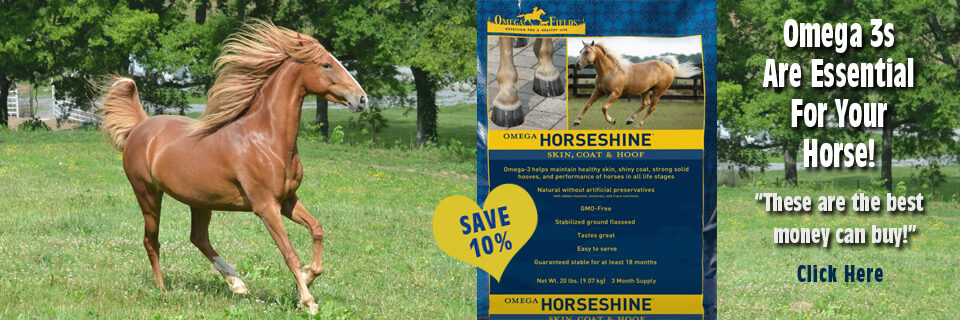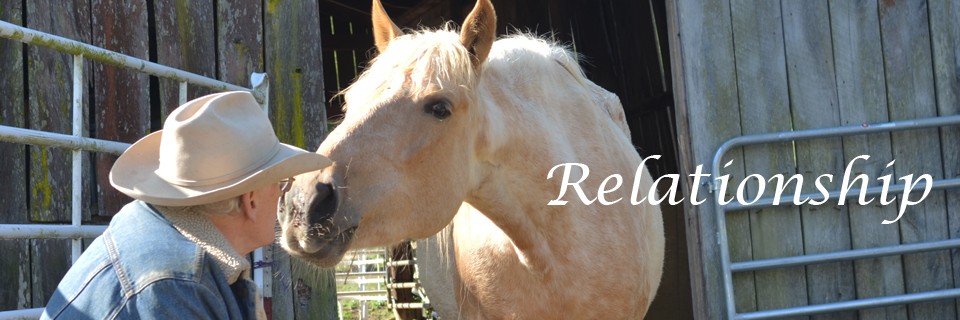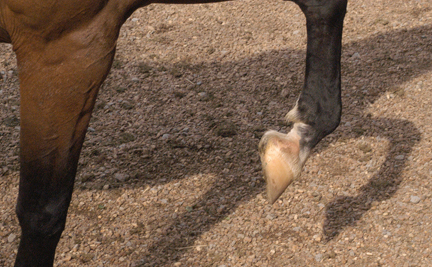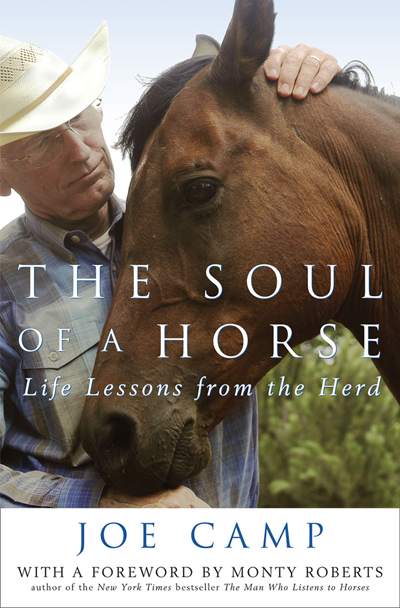 Cash – showing off a bit of barefoot ballet
Cash – showing off a bit of barefoot ballet
Shortly after our first three horses had shown up in our front yard I stumbled into wild horse research trying to uncover why Cash had come to us with shoes on his front feet but none on his back feet. We had been told that concrete and asphalt would crack and shatter any horse’s hoof that was not wearing a shoe. If that were true, I needed to get shoes on his back feet right now because we had concrete and asphalt everywhere.
And I suppose I had wondered – apparently too often too loud – how wild horses had managed to exist all this time without help from humans? Could it be the wild ones might be able to teach us a thing or two?
Oh no. Generations of selective breeding have completely changed everything about the domesticated horse.
I had been told that again and again. But then I happened upon Jaime Jackson’s research on how wild horse hooves work and look, and why. And how well their hooves had protected them and helped them survive for millions of years.
To a prey animal like a wild horse there is nothing more important than good rock-solid feet. They travel up to thirty miles a day in search of food and water. And they run a lot from predators.
All without metal shoes.
But apparently I was wasting my time. That information was all immaterial. The wild horse and the domesticated horse were different species.
Everybody said so.
A few hundred years of selective breeding had made it so.
Domesticated horses no longer had the same feet as their wild counterparts.
A domesticated hoof was destined to be weak and underdeveloped. Often sick and unhealthy. A domesticated hoof needed a metal shoe.
The American Farriers Journal reported that 95% of all domesticated horses have some sort of lameness issue. That’s why they have to wear shoes, I was told.
But my Cash came to us with only two shoes. On the front feet. Nothing on the rear feet.
So was he half wild and half domestic?
It was worrisome that his back end would be the wild part. The kicking end.
All of this was gnawing at the edges of logic.
There is no hoof lameness in the wild. And it runs rampant throughout the domestic scene.
But unlike everyone else we had encountered, Jaime Jackson believed that wild hoof mechanics were exactly the same as domesticated hoof mechanics, both depending upon the hoof to flex with every step taken. Like a toilet plunger. This flexing sucks an enormous amount of blood into the hoof capsule every time the hoof hits the ground; and pushes it back up the leg when the hoof leaves the ground. Like a mini-heart, pumping with every step. Among other things this keeps the hoof healthy and growing properly.
And what happens when a metal shoe is nailed to the hoof?
Nothing.
No flexing.
No blood.
No function.
The curtains were parting. A veil lifting. It wasn’t about whether a horse was domesticated or wild. It was about blood circulation. And the effect of that circulation – or lack of it – on the health of the hoof.
No, no, no. We’ve unfortunately bred the foot right off the horse.
I smiled politely.
Knowledge is king.
I had just read in a scientific journal that it would take a minimum of 5000 years to change the base genetics of any species. Probably more, depending upon the circumstances. A few hundred years of selective breeding could have no affect whatsoever on base genetics.
Which is why a newborn foal will still be on his feet less than an hour after being born – thinking, learning, eating – and in less than four hours be ready and able to move out with the herd to stay away from predators. Even if he’s born in a stall.
The genetics haven’t changed.
It’s also why the stresses, illnesses, and vices caused by being confined to a stall can be solved by allowing horses to be out with each other 24/7. And it’s why barefoot “domestic” horses living out with a herd and eating a proper diet from the ground are able to develop rock-solid hooves that have no use for metal shoes.
I called our vet.
“The shoes are coming off ,” I said.
“Uhh… whose?”
“All of ‘em.”
Silence.
Then, “Why not try one at a time and see how it goes?”
“Nope. All six.”
In a week it was done.
And not one of our horses ever looked back. I had never seen a horse smile until the day Cash’s shoes were removed.
Scribbles, our paint, had hooves that were so sick that he had to grow a whole new foot, from hairline to the ground. It took eight months. But then he too was a happy camper.
 Scribbles – eight months after shoes – California
Scribbles – eight months after shoes – California
 Pocket – six months after shoes – California
Pocket – six months after shoes – California
 Cash – just a few weeks after shoes – California
Cash – just a few weeks after shoes – California
How could this be? Domesticated horses need shoes because their feet are sick, soft, and unhealthy. Over and over again we were told. Or could it be that their feet are sick, soft, and unhealthy because of the metal shoes nailed to their feet restricting the circulation and eliminating the natural hydraulic-like shock absorption the intake of blood provides to protect the joints, ligaments, and tendons of the leg? I guess that’s why the folks who run the country’s largest mounted police patrol in Houston, Texas, have not one shoe on their forty or so horses who work all day every day on the concrete, asphalt, and marble of downtown Houston. Forty or so horses of every variety and every type of background. And not one shoe. Which eliminates the oft heard argument that some horses can go barefoot, but some cannot. All of theirs are barefoot and healthier for it. Unfortunately I didn’t know any of this at the time.
“Which means that wild and domestic horses are not two different species at all,” Kathleen said. “They’re the same.”
“I could turn Cash out into the wild and he’d be fine,” I said.
“Down boy. That’s taking research a step too far.” She wasn’t smiling.
The American Association for the Advancement of Science says that every horse on the planet “retains the ability to revert to living in the wild successfully.” Note they use the word successfully.
DNA sequences taken from long bone remains of horses found preserved in the Alaskan permafrost dated 12,000 to 28,000 years ago differ by as little as 1.2% from the modern domestic horse.
So genetically speaking there was really no difference between a horse living in the wild and a so-called domesticated horse. What each horse has learned from his or her environment is obviously different, as I would soon come to understand. But their genetic ability to live successfully in the wild is the same.
And there was good news in the realization.
We had in our care perhaps the only species on the planet that lives with humans but could boast its own living laboratory in the wild. No more need for guesswork. These wild horses could reveal the truth, be a road map to the way horses were designed to live. A way that works because they have survived for 52 million years without any help from us.
If it hadn’t worked so well we would’ve never heard of the horse.
God and Mother Nature knew what they were doing. Horses were designed over time through trial and error to live and eat and move in certain ways; and the study of all of this could provide more incredibly valuable information about how we should be feeding, keeping, and caring for the horses we choose to associate with than has ever been understood before.
When a shoe comes off a horse that has been shod for years and years, the hoof and hoof wall are usually no longer strong and healthy. The hoof has been made unhealthy by lack of circulation because it has not been able to flex and thus circulate the blood properly throughout the hoof mechanism. And the continuing process of hammering nails into the hoof wall makes it weaker, and provides places (the nail holes) for chips and cracks to occur. Also, some hooves, if they’re really in bad health, will be tender for a while after going barefoot. And the unknowing owner concludes that the tenderness means the horse needs shoes.
Not so.
The hoof will completely heal and remodel itself and grow strong new horn and hard calloused sole. This is a logical and normal process (see the Resources section at the back of the book, especially Pete Ramey’s and Jaime Jackson’s books and videos). It takes approximately eight months for a horse to grow a new hoof, from his hairline to the ground. If properly trimmed to mimic the way wild horses’ hooves trim themselves during daily wear, a worst-case scenario for a horse to acquire a completely new, rock solid, healthy foot, then, is approximately eight months. Many horses are much quicker. As you read earlier, Cash was good to go from the first day his shoes came off. And a happy horse indeed. Four of our six never had a tender moment after going barefoot. One took four months to remodel, and one took almost eight months. And well worth the time.
But wait! When my horse’s shoe falls off, he starts limping almost immediately. And when the shoe is nailed back on, suddenly he’s fine. Doesn’t hurt anymore. Proof that the shoe is better for him than barefoot.
Have you ever crossed your legs for so long that your foot goes to sleep? We all have, and we all know what’s happening. The leg-cross has cut off the circulation to the foot, and with no circulation, the nerve endings lose their sensitivity and fail to work. The second you uncross, or stand up, the circulation returns, as do the nerve endings.
Ooohh! Ouch!
The same thing happens to a horse when a metal shoe is nailed on. The inability of the hoof to flex removes its ability to pump blood, virtually eliminating circulation in the hoof mechanism. Without proper circulation, the nerve endings quit transmitting, and the horse no longer feels the “ouch.” When the shoe falls off, the circulation returns and suddenly he can feel again.
Whoa, what’s that about??
 This is a thermograph of the blood circulation in the legs and hooves
This is a thermograph of the blood circulation in the legs and hooves
of a horse wearing one nailed-on metal shoe, on the front right.
The other three hooves are barefoot.
The rest is between you and your horse.
Convince yourself. Try this test. On a cool day, or under cover, feel the hoof and lower leg of a shod horse, and a hoof of another who is barefoot. The barefoot horse’s lower leg and hoof will feel warm to the touch, because of the blood circulating within. The shod horse’s lower leg and hoof will be cool, not warm, because of the blood that is not circulating within. Or simply study the thermograph above.
As mentioned earlier, our Scribbles took a good seven to eight months to regain a healthy hoof with no ouch. And today he’s a happy camper, on asphalt or concrete, on the trail, in the arena. His hooves are beautifully concaved, keeping the coffin bone up where it belongs. They are beveled at the edges, just like a wild horse’s hoof. And they’re as hard as stone.
The sacrifice? The downside?
A few months time to let him grow the hoof nature always intended for him to have. Good boy, Scribbles.
How much trimming is needed, and how often, depends upon the horse’s environment and lifestyle. Remember, the objective is to help the horse replicate the hoof that he would grow if he were living in the wild, moving twelve to fifteen miles a day with the herd. If he’s living in a Virginia pasture or, heaven forbid, a box stall and not moving around much, there will be a lot more trimming, probably more often, than if he were living in a high desert natural “pasture” like ours was in California and moving around all day wearing down his own hooves. But the objective can be reached in any case.
Pete Ramey, a hoof specialist who teaches hoof care all over the world, believes we have only just begun to discover the true potential of the wild horse model. After a trip to wild horse country for research he said, “The country was solid rock; mostly baseball-sized porous volcanic rock that you could literally use as a rasp to work a hoof if you wanted to. Horse tracks were fairly rare, because there was so little dirt between the rocks. There were a few muddy areas from the recent snow melt, but they were littered with rocks as well. The horses made no attempt to find these softer spots to walk on.”
Pete and his wife, Ivy, observed, videotaped, and photographed at least sixty horses. All of them, from the foals to the aged, moved effortlessly and efficiently across the unbelievably harsh terrain. According to Pete, the horses were doing collected, extended trots across an obstacle course that would shame the best show ring work of any dressage horse, with their tails high in the air and their heads cocked over their shoulders watching the intruding couple.
“I have never known a horse I would attempt to ride in this terrain,” Pete says. “Ivy and I had to literally watch our every step when we were walking. The movement of the horses was not affected by the slippery dusting of snow on the rocks. In fact, they got around much better than the mule deer and the pronghorns. The entire time we were there we did not see a limp, or even a ‘give’ to any rock, or a single lame horse, and not one chip or split in any of their hooves. It was an unbelievable sight.”
The world has been shocked and amazed by the ability of Pete and others to forge rock-crushing bare hooves, boost equine performance, and treat “incurable” hoof disease. “I don’t want to diminish these facts,” Pete says, “but I now realize that we haven’t even scratched the tip of the iceberg.”
Pete is my hero! He is much of the reason for the existence of my book The Soul of Horse. He cares so very much about the horse and proves it daily by how much time he spends researching the complex internal workings of the horse’s hoof and the myriad factors that affect its health. And substantiating that research on the horses in his care. In his DVD series, Under the Horse, Pete lays every bit of it out for us. If you’ve ever doubted the fact that horses do not need metal shoes and are in fact better off without them, please see this series. Pete will convince you of this undeniable truth. In my humble belief, whether or not you ever intend to trim your own horse’s feet, Under the Horse is one of the most valuable and user-friendly compilations of knowledge, research, and insight for improving the health and lifespan of your horse that exists on the planet. And believe it or not, The American Farriers Association (the metal shoe group) agrees. An excerpt from their review:
“Pete Ramey’s set of DVD’s is without a doubt a must-have series for any equine professional farrier or horse owner. Pete Ramey offers wisdom and insight that his years of practice and study have given him. If you own only one hoof care DVD series, this should be it.” American Farriers Journal
Pretty impressive for an organization of metal shoers.
There’s an old expression: No hoof, no horse. And the reams of research I’ve pored over truly made that point. So much of what can go wrong with a horse begins or is controlled by the health of the hoof. When that hoof is healthy, is flexing, and taking stress off the heart, it can add years to a horse’s life.
And he’ll be happier.
Not only because he feels better, but because he can actually feel the surface he’s walking on, which makes him more comfortable and more secure in his footing. It’s the way nature intended. Would you run on the beach with boots on? Or do you want to feel the sand between your toes? Not a perfect analogy, but you get the idea (See Happier Healthier Horses).
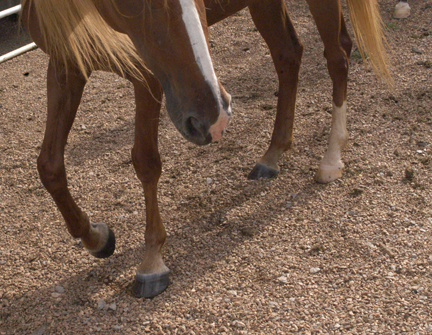 Mouse – a happy horse indeed – Tennessee
Mouse – a happy horse indeed – Tennessee
The president of the American Farrier’s Association, in a speech to his constituency reported in the organization’s publication, said that 95% of all the domestic horses on this planet have some degree of lameness. I wonder if he told them why. Or that it’s a rare occurrence indeed to find a lame horse in the wild. Dr. Jay Kirkpatrick, director of the Science and Conservation Center in Billings, Montana, has studied wild horses most of his adult life and says that lameness in the wild is extremely rare and virtually every case he’s seen is related to arthritic shoulder joints, not hoof problems.
All of the above is why our horses’ shoes came off. How could I know all this, understand all this, and not do it. I had, after all, promised Cash.
So think about it. Think seriously about it every time you hear someone say that what they do for a living is better for your horse than what the horse would do for itself in the wild. Ponder the presidents of those tobacco companies testifying before Congress, emphatic that tobacco was not harmful. Dig around on your own. Do some research. Compare what “the experts” say. Gather your own knowledge and don’t let someone else make decisions for you. Whether it’s about your horses, or your life.
And if you do own a horse, show him that he’s not an ox, or a tractor, or a motorcycle. He’s your partner.
And let him know by your leadership that you love him and will give him the best care you possibly can.
For more on Why Our Horses Are Barefoot:
10 Questions Before Hiring a Trimmer
Order Personally Inscribed Why Our Horses Are Barefoot – $6.99
——
The story of our journey with horses (to date) is told in the two books that follow: the national best seller The Soul of a Horse – Life Lessons from the Herd and its sequel Born Wild – The Soul of a Horse.
And what a story it is as two novices without a clue stumble and bumble their way through the learning process so that hopefully you won’t have to. If you haven’t read both of these books already please do because with that reading, I believe, will come not just the knowledge of discovery but the passion and the excitement to cause you to commit to your journey with horses, to do for the horse without waiver so that your relationship and experience will be with loving, happy and healthy horses who are willing partners and who never stop trying for you. Horses like ours.
The highly acclaimed best selling sequel to the National Best Seller
The Soul of a Horse – Life Lessons from the Herd
#1 Amazon Best Seller
#1 Amazon “Hot New Releases”
Amazon & Kindle
B&N and Nook
Apple iBooks
Google play
Order Personally Inscribed Copies of Born Wild – $15
Order Both The Soul of a Horse & Born Wild – Save 20%
Both Personally Inscribed – $24
Please list the names for each inscription in the “instructions to Seller” field as you check out!
Read More About Born Wild
Read More About The Soul of a Horse
Watch The Soul of a Horse Trailer
Watch the Born Wild Trailer
But first read the National Best Seller that started it all:
Amazon & Kindle
Barnes & Noble & NOOKbook
Apple iBooks
Order Personally Inscribed Copies of The Soul of a Horse – $15
Order Both The Soul of a Horse & Born Wild – Save 20%
Both Personally Inscribed – $24
Please list the names for each inscription in the “instructions to Seller” field as you check out!
Read More About Born Wild
Read More About The Soul of a Horse
Watch The Soul of a Horse Trailer
Watch the Born Wild Trailer
“Joe Camp is a master storyteller.” – The New York Times
“One cannot help but be touched by Camp’s love and sympathy for animals and by his eloquence on the subject.” – Michael Korda, The Washington Post
“Joe Camp is a natural when it comes to understanding how animals tick and a genius at telling us their story. His books are must-reads for those who love animals of any species.” – Monty Roberts – Author of New York Timers Best-seller The Man Who Listens to Horses
“Camp’s tightly-written, simply-designed and powerfully drawn chapters often read like short stories that flow from the heart.” Jack L. Kennedy – The Joplin Independent
“Joe Camp is a gifted storyteller and the results are magical. Joe entertains, educates and empowers, baring his own soul while articulating keystone principles of a modern revolution in horsemanship.” – Rick Lamb – TV/Radio host – The Horse Show
Watch this video
How We Kept Six Barefoot Horses
Moving and Eating Happily,
Healthily on an Acre and a Half
of Rock and Dirt
Follow our latest journey with two amazing new arrivals from the wild. Kathleen’s terrific photos are worth the click.
In chronological order:
What an Extraordinary Weekend!
Firestorm’s Amazing First Day in the Playpen
No-Agenda Time – So Much Value!
An Amazing Birthday Gift from a Wild Mustang!
Saffron and Firestorm – Progress and Photos – Lots of Both!
Two Mustangs – Three Mind-Boggling Months!
For more current posts go to the blog homepage and scroll down
Go to TheSoulOfaHorse.com Homepage
Visit The Soul of a Horse Channel on YouTube

















